Partner Categories, Partner Types, Partner Business
Navigate partner terminology with confidence. Understand channel partners, resellers, affiliates, and integration partners clearly.
In business, we hear all these different names for partners—like channel partners, resellers, affiliates, agencies, integration partner and so on. It gets pretty confusing, right?
It's easy to get mixed up about what these terms actually mean and how they differ from one another. This confusion can muddle our expectations and relationships.
This guide is here to clear things up. We're going to break things down and really dig into what each partner does and how they contribute. We'll look at partners in three main ways: by their strategic contribution (Partner Categories) to your Business Functions, by their operational role (Partner Types), and how they would describe their own activity (Partner Business).
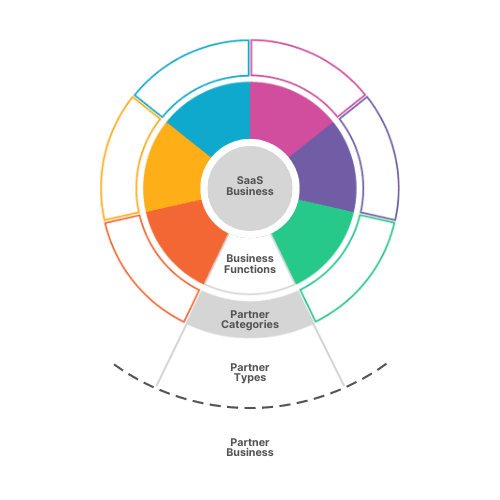
To make sense of this, we'll use a SaaS partner ecosystem as our example. Understanding your partner ecosystem through Business Functions, Partner Categories, Partner Types, and Partner Business is a proven approach that I have used and optimized over the years and I am sure it will help you.
Ready? Let’s dive in and demystify this partner jargon!
Business Functions
When looking for new partners you usually start by looking from inside your business and its functions you like to support by partners. Partners can contribute to various functions. Here are the primary Business Functions:
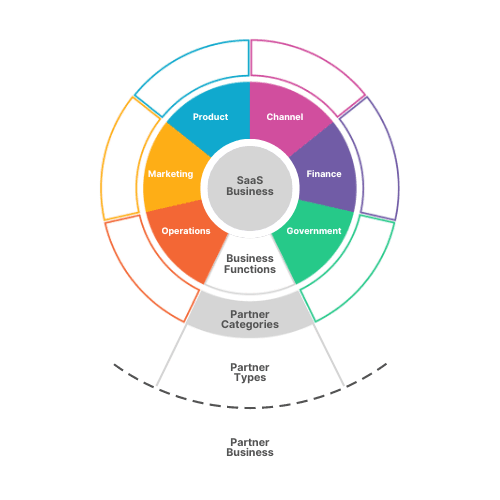
- Product: Development and enhancement of products.
- Channel: Distribution and sales routes to market.
- Marketing: Branding, Promotion and outreach to potential customers.
- Operations: Management of day-to-day business activities.
- Finance: Financial management and investment activities.
- Government: Interaction with regulatory bodies and policy-making entities.
The Business Functions are not limited to the six mentioned above. These are a few examples. Take a look at your own business model and figure out which functions are part of your business and could thrive through the support from partners.
Partner Categories: Strategic Contributions
Once you've identified the business functions where you need support, the next step is to understand the strategic contributions partners can make. This is where Partner Categories come into play. Partner Categories describe the broad role and impact that a partner has within your business. Each partner category aligns with a specific business function your strategic goals in this functions.
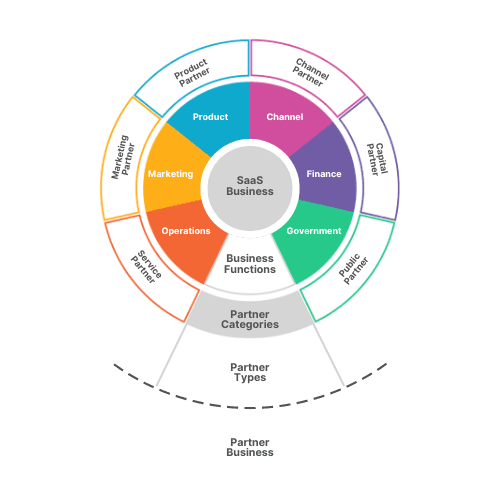
-
Product Partner, enhance the product function through activities such as co-development, feature integration, and data integration. These partners can help accelerate innovation and bring additional value to your product by incorporating new technologies, extending functionality, or providing essential data.
-
Channel Partner, contribute to revenue generation by promoting, reselling, or distributing your products or services. They play a role in expanding your market reach, penetrating new markets, and driving sales. Examples include resellers, distributors, and referral partners.
-
Marketing Partner, increase brand awareness, market education, and lead generation. They support your marketing efforts through various activities like digital marketing, content creation, and event coordination. These partners help amplify your message, attract new customers, and maintain engagement with your audience.
-
Service Partner (Operations Partner), support any operational function that is required to deliver or maintain your product or service effectively. This includes partners that provide logistics, customer support, IT services, HR functions, and more. These partners ensure that your business operations run smoothly and efficiently, enabling you to focus on core activities.
-
Finance Partner: bolster your financial function through capital investment, financial advice, and management. These partners can provide necessary funding, manage your financial records, and guide strategic financial planning, helping you sustain and grow your business. Yes, your investor is a partner!
-
Public Partner, facilitate compliance with regulations and advocate on behalf of your business within the governmental and public sectors. These partners work collaboratively to ensure legal compliance and can help influence policy in a way that supports your business goals.
Partner Types: Operational Roles
Within each Partner Category, partners take on various operational roles. Partner Types describe the specific tasks and responsibilities that partners handle on a day-to-day basis. Understanding these roles helps manage the partnerships more effectively and setting clear expectations.
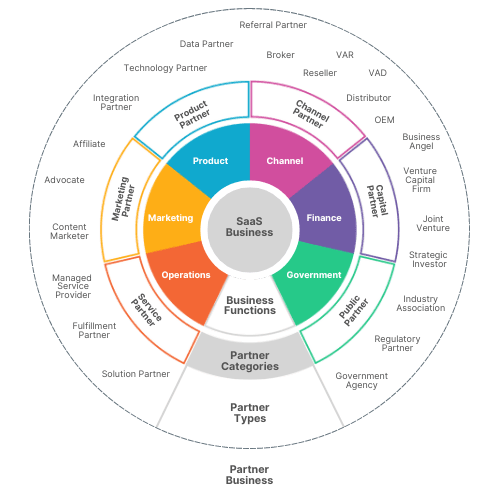
Here are some examples of Partner Types within each category. As mentiond earlier you type of partner may differ from the below. The important point here is that Partner Type clearly fulfill an operational role.
Product Partner
- Technology Partner: Supplies technological components or platforms.
- Data Partner: Provides essential data to enhance product functionality.
- R&D Partner: Engages in research and development activities.
Channel Partner
- Reseller: Resells the company's products to end customers.
- Distributor: Distributes products to resellers or retailers.
- Referral Partner: Refers potential customers to the business.
- OEM Partner: Incorporates the company's products into their own solutions and rebrands them.
Channel Partner Types (SaaS) and their roles in the customer journey
Marketing Partner
- Affiliate: Promotes the company's products through affiliate marketing programs.
- Content Partner: Creates and distributes engaging content to attract and retain customers.
- Brand Ambassador: Promotes the brand through personal influence and networking.
Service Partner
- Managed Service Provider: Offers ongoing management of IT services and infrastructure.
- Fulfillment Partner: Ensures the efficient delivery of SaaS offerings and manages service provisioning.
- Solution Partner: Integrates various SaaS solutions to provide comprehensive, tailored services to meet client needs.
Capital Partner
- Business Angel: Provides early-stage funding and mentorship to startups.
- Venture Capital Firm: Offers capital and strategic support to high-growth potential businesses.
- Joint Venture: Collaborates on a business enterprise, sharing profits, losses, and control.
- Strategic Investor: Invests in the business with the intention of creating synergies and enhancing strategic alignment.
Public Partner
- Industry Association: Collaborates on industry-wide initiatives, interests and standards.
- Regulatory Partner: Guides compliance and advocates for business-friendly regulations.
- Government Agency: Engages in joint projects and initiatives for public welfare and compliance.
Partner Business: Independent Activities
Understanding the independent business activities of potential partners can help you identify and connect with the right partners. This involves recognizing how these partners describe themselves and their core operations.
To make this point clearer: An Agency could be a reseller, a referral partner, a affiliate, a content partner, a brand ambassador, a fulfillment partner an so on. That why an Agency is not a Partner Type, but a term to define the Partner’s Business.
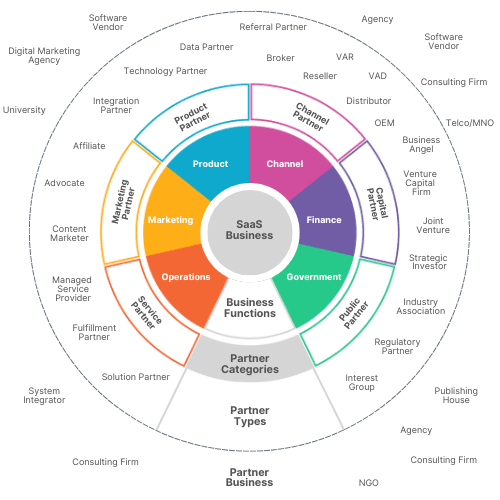
Here are some common types of Partner Businesses:
- Agency: Provides specialized services such as marketing, advertising, or creative work.
- Consulting Firm: Offers expert advice, strategic planning, and specialized knowledge in various fields.
- Software Vendor: Develops and sells software products or platforms.
- Research Institute: Conducts scientific or market research and development.
- Logistics Company: Manages transportation, warehousing, and supply chain operations.
- Educational Institution: Engages in teaching, training, and research activities.
- Non-Profit Organization: Focuses on social, environmental, or community-driven initiatives.
- System Integrator: Combines various technology solutions to meet specific business needs.
- Software Association: Represents the interests of a specific industry, facilitating collaboration and standard-setting.
Wondering what "Strategic Partners" are?
While we've covered various partner categories and types, it's important to highlight a special class of partnerships: Strategic Partners. These partnerships add an extra layer of depth to the relationship, going beyond typical operational collaborations.
Strategic partners (in contrast to "regular" partners) add an additional dimension to the relationship. They become part of your strategic planning in market or product development. For example, you might expand to another country on the other side of the globe and count on a strategic partner to achieve this goal. Strategic partnerships may also have an investment component; you may build a joint venture or even merge later on.
Key Characteristics of Strategic Partners:
- Long-term Vision Alignment: Strategic partners are deeply integrated into your company's future plans and overall strategy.
- Mutual Growth: Both parties invest significant resources and effort into each other's success.
- High-Level Collaboration: Involvement in strategic planning for market expansion or product development.
Examples of Strategic Partnerships:
- Global Expansion: Partnering with a local company to enter a new market on the other side of the globe. Often, this partner has the right to distribute to its own reseller network.
- Technology Integration: Deep integration of technologies to create a unique, combined offering in the market. That goes beyond adding a feature and touches the core technology of a business.
- Joint Research & Development: Pooling resources and expertise to push the boundaries of innovation in your industry.
Strategic partnerships can span across multiple partner categories we've discussed earlier. For instance, a strategic partner could be both a Product Partner and a Channel Partner, deeply involved in both product development and market expansion.
Ready to Map your Partner Ecosystem?
By answering these three key questions:
- What is the strategic contribution of your partner? - Partner Category
- What is the operational role of your partner? - Partner Type
- What are the partner's usual day-to-day activities? - Partner Business
You create a common language that helps ensure you, your colleagues and your partners are on the same page when discussing partnerships. This leads to better partner selection and improved communication.
Your ecosystem may differ from the above to may a suitable for business case. For example you may have additional categories & types. However I encourage you to implement a certain level of standardization. Feel free to adopt the terms from the glossary below and don't hesitate to reach out if like to discuss or add something.
Glossary
Partner Types
- Referral Partners — Help drive brand awareness and customer referrals
- Resellers & Distributor — Sell and distribute the products to customers
- [Managed Service Providers] — Deliver professional services and support around the SaaS products
- OEMs — Incorporate the products in parts or completely into their own offerings
- Technology Partners — Provide products or infrastructure that complement or enhance the technology offerings
Partner Categories
- Channel Partners — Focus on sales, distribution, and reaching new markets
- Product Partners — Enhance and expand the product portfolio
- Service Partners — Deliver professional services and support
- Marketing Partners — Amplify brand awareness and exposure